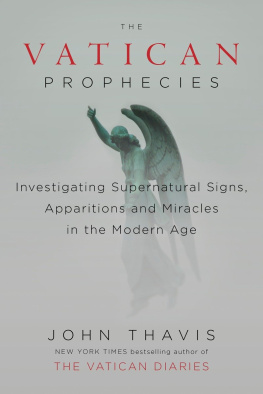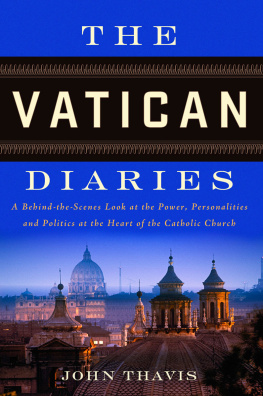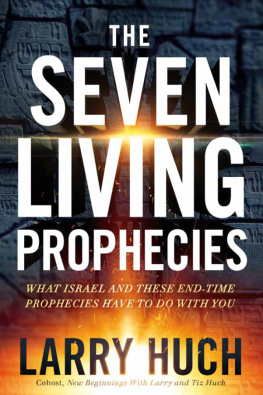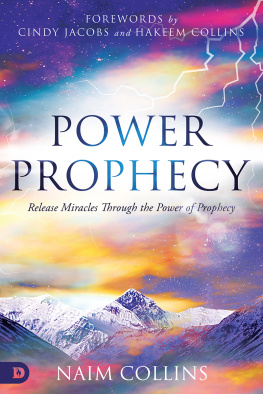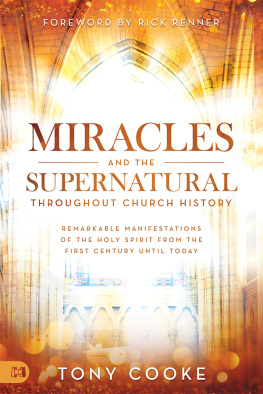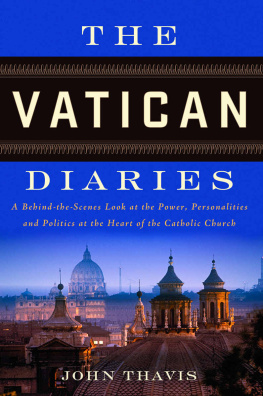John Thavis - The Vatican Prophecies: Investigating Supernatural Signs, Apparitions, and Miracles in the Modern Age
Here you can read online John Thavis - The Vatican Prophecies: Investigating Supernatural Signs, Apparitions, and Miracles in the Modern Age full text of the book (entire story) in english for free. Download pdf and epub, get meaning, cover and reviews about this ebook. year: 2015, publisher: Penguin Publishing Group, genre: Religion. Description of the work, (preface) as well as reviews are available. Best literature library LitArk.com created for fans of good reading and offers a wide selection of genres:
Romance novel
Science fiction
Adventure
Detective
Science
History
Home and family
Prose
Art
Politics
Computer
Non-fiction
Religion
Business
Children
Humor
Choose a favorite category and find really read worthwhile books. Enjoy immersion in the world of imagination, feel the emotions of the characters or learn something new for yourself, make an fascinating discovery.
- Book:The Vatican Prophecies: Investigating Supernatural Signs, Apparitions, and Miracles in the Modern Age
- Author:
- Publisher:Penguin Publishing Group
- Genre:
- Year:2015
- Rating:3 / 5
- Favourites:Add to favourites
- Your mark:
- 60
- 1
- 2
- 3
- 4
- 5
The Vatican Prophecies: Investigating Supernatural Signs, Apparitions, and Miracles in the Modern Age: summary, description and annotation
We offer to read an annotation, description, summary or preface (depends on what the author of the book "The Vatican Prophecies: Investigating Supernatural Signs, Apparitions, and Miracles in the Modern Age" wrote himself). If you haven't found the necessary information about the book — write in the comments, we will try to find it.
John Thavis: author's other books
Who wrote The Vatican Prophecies: Investigating Supernatural Signs, Apparitions, and Miracles in the Modern Age? Find out the surname, the name of the author of the book and a list of all author's works by series.
The Vatican Prophecies: Investigating Supernatural Signs, Apparitions, and Miracles in the Modern Age — read online for free the complete book (whole text) full work
Below is the text of the book, divided by pages. System saving the place of the last page read, allows you to conveniently read the book "The Vatican Prophecies: Investigating Supernatural Signs, Apparitions, and Miracles in the Modern Age" online for free, without having to search again every time where you left off. Put a bookmark, and you can go to the page where you finished reading at any time.
Font size:
Interval:
Bookmark:
Also by John Thavis
The Vatican Diaries

VIKING
An imprint of Penguin Random House LLC
375 Hudson Street
New York, New York 10014
penguin.com
Copyright 2015 by John Thavis
Penguin supports copyright. Copyright fuels creativity, encourages diverse voices, promotes free speech, and creates a vibrant culture. Thank you for buying an authorized edition of this book and for complying with copyright laws by not reproducing, scanning, or distributing any part of it in any form without permission. You are supporting writers and allowing Penguin to continue to publish books for every reader.
ISBN 978-0-698-15631-9
Version_1
To my parents, Alice and Richard
Then some of the scribes and Pharisees said to him, Teacher, we wish to see a sign from you.
THE GOSPEL OF SAINT MATTHEW
At the Crossroads of Reason and Wonder
 The Mexican man fidgeted in a wheelchair, waiting for a blessing from Pope Francis. It was Pentecost Sunday in May 2013, two months after Franciss election, and there was already extraordinary public enthusiasm for the new pontiff. The popes down-to-earth and unpredictable style had captured the worlds attention, and TV cameras followed his every move. Like his predecessors Francis ended his liturgies by personally greeting a line of the sick and their caregivers. On this day they had assembled in a shaded corner of Saint Peters Square. Among them were pilgrims with cancer, cerebral palsy, multiple sclerosis, muscular dystrophy, and other serious infirmities.
The Mexican man fidgeted in a wheelchair, waiting for a blessing from Pope Francis. It was Pentecost Sunday in May 2013, two months after Franciss election, and there was already extraordinary public enthusiasm for the new pontiff. The popes down-to-earth and unpredictable style had captured the worlds attention, and TV cameras followed his every move. Like his predecessors Francis ended his liturgies by personally greeting a line of the sick and their caregivers. On this day they had assembled in a shaded corner of Saint Peters Square. Among them were pilgrims with cancer, cerebral palsy, multiple sclerosis, muscular dystrophy, and other serious infirmities.
The young man from Mexico, Angel V., did not suffer from any common illness or disability, however. He was convinced that he was possessed by the devil. For years exorcists in Rome had tried, unsuccessfully, to cast out his demons. One of them believed that Angel was possessed by no fewer than four evil spirits; ridding him of them would require a prodigious spiritual effort. But where ordinary exorcists had failed, perhaps a pope could succeedespecially a pope like Francis, who in his first weeks had shocked listeners by describing the devil as a real force in the modern world, and warning Christians to guard against Satans cunning ways. After repeated attempts, Angels clerical friends in Rome had finally received permission to bring him to the papal Mass. For the Vatican he was just one more sick person in a wheelchair, but for a small group of priests seeking to revive the exorcism ministry, he was an important test case.
Pope Francis was unaware of all this as he made his way down the line of the ill and impaired, greeting each sufferer and leaning in to offer a few words of comfort. When he came to Angel, he laid his hands on top of the mans head. Angel began to writhe and breathe heavily. His mouth opened wide, emitting a strange howling sound, and then he slumped in his chair. Vatican security guards quickly blocked the view of the professional photographers who were present and moved the pope along.
Had Pope Francis just performed an exorcism? The media headlines and YouTube postings suggested that he had, and several priests who routinely did exorcisms agreed. If not the full-blown exorcism rite, they said, Francis had at least recited a prayer of liberation from Satan, and the dramatic effect of the popes intervention was there for all to see. A few hours later, however, the Vatican spokesman, Father Federico Lombardi, categorically denied that Pope Francis had conducted an exorcism. The pope had simply said a generic prayer to relieve suffering, which he often offered to the sick. For the Vatican, the case was closed.
This episode, described in greater detail in the fourth chapter of this book, is a striking example of the Vaticans extreme sensitivity to any suggestion of the existence of real-world demonic manifestation. The devil may be acceptable as a theological reality, but not as a personality who makes people howl, levitate, speak in unknown languages, and exhibit superhuman strengthall classic signs of possession, but far too Hollywood for modern Vatican tastes.
In a wider sense the exorcism of Angel V. highlights a growing tension between the Vaticans more intellectual approach to faith, heavily skewed toward philosophical and doctrinal assertions, and the popular thirst for something more tangible. In an age in which Christianity is supposed to be the faith of reason, many are still fascinated by the possibility of miracles, apparitions, encounters with the devil, and other signs of the supernatural.
Balancing these two aspects of faith is a task that has increasingly occupied the Vaticans time and resources. In recent years its offices have issued a series of instructions aimed at controlling devotional and mystical experiences whenever they threaten to disturb the churchs beliefs and practices. In a sense the Vatican is engaged in vetting the supernatural and filtering wondrous experiences, to minimize anything it judges unorthodox, superfluous, excessive, or bizarre. At the same time, of course, officials in Rome cannot be seen as placing limits on divine intervention, including the possibility of Gods intercession in everyday lifethat would be viewed as betraying the churchs oldest traditions.
The diverse forms of the supernaturalmiraculous events, apparitions, healings, prophecies, and demonic interferencehave been essential elements of Christianity from the moment God said Let there be light in the Book of Genesis. The wonders of creation brought about by the word of God were followed by numerous Old Testament accounts of divine favor or retribution: the Nile River turning to blood, one of the ten plagues of Egypt; the withered hand of King Jeroboam, who tried to silence a prophet; the diviner Balaams donkey, who spoke to his master in a mans voice; or the revelations received by biblical prophets like Daniel, who foretold events from his own time to the End Times. The life of Christ was marked by an even more intense flurry of supernatural activity. Jesus raised the dead, healed the sick, restored sight to the blind, cast out demons, changed water into wine, fed the multitude with a few loaves and some fish, and walked on water. The New Testament records thirty-seven miracles of Christ, but as the Gospel of John states, There are also many other things that Jesus did, but if these were to be described individually, I do not think the whole world would contain the books that would be written.
According to scriptural accounts the Apostles continued to perform miraculous wonders after Christs death. They cured the ill and the lame, rid men and women of evil spirits, caused prison gates to burst open, and experienced prophetic visions. Saint Peters spiritual powers were so great that even his passing shadow was said to have healed the sick. Miracles came to be seen as an important indicator of sainthood, and in the eighteenth century the Vatican established formal criteria for validating miracles as part of the canonization process.
In a very physical way, pieces of human bone and other relics came to preserve the link to the early Christian evangelizers and saints, and their supposed supernatural potency made them fixtures in churches in Europe and, in later centuries, on every other continent. In the Middle Ages relics retrieved from the Holy Land assumed greater importance as communities began to rely on their patronage and protection. Sometimes even small towns would honor a whole pantheon of patron saints, each of whom specialized in overcoming a particular type of disease or adversity. Prayers answered by saintly intercessors were often memorialized with ex-voto offerings, new shrines, or the construction of major churches.
Font size:
Interval:
Bookmark:
Similar books «The Vatican Prophecies: Investigating Supernatural Signs, Apparitions, and Miracles in the Modern Age»
Look at similar books to The Vatican Prophecies: Investigating Supernatural Signs, Apparitions, and Miracles in the Modern Age. We have selected literature similar in name and meaning in the hope of providing readers with more options to find new, interesting, not yet read works.
Discussion, reviews of the book The Vatican Prophecies: Investigating Supernatural Signs, Apparitions, and Miracles in the Modern Age and just readers' own opinions. Leave your comments, write what you think about the work, its meaning or the main characters. Specify what exactly you liked and what you didn't like, and why you think so.

